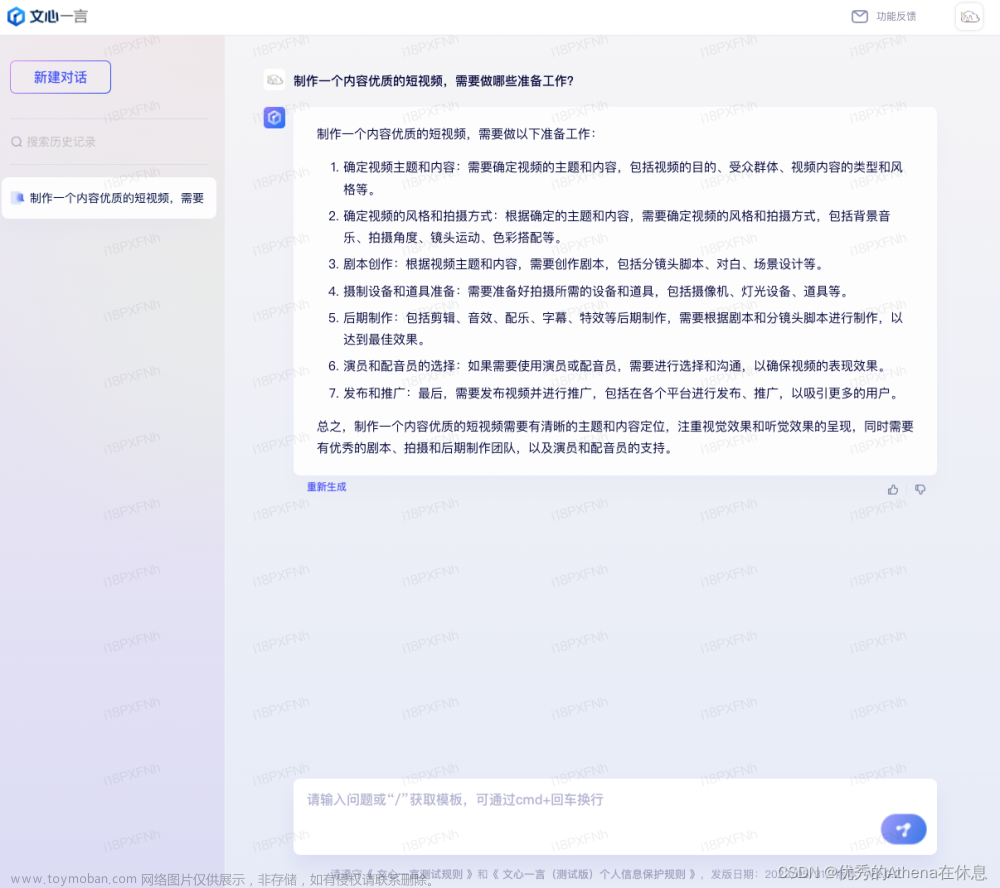我生成了一个蔡徐坤 唱、跳、RAP的字符视频,链接为:
蔡徐坤唱跳RAP字符视频
使用python将一个视频转换为字符视频
详细视频教程,总共8分钟。
用python制作字符视频详细教程(视频版)
文字教程见下文:
首先需要安装python
然后安装所需要的包:cv2、PIL
具体安装方法:
安装cv2
pip install opencv-python安装PIL
pip install pillow在安装过程中经常遇到安装时间过长、安装失败等问题。
可以在官网下载对应版本的whl文件,采用本地安装的方法。
opencv-python官方下载地址
pillow官方下载地址
我的博客下载地址
下载时需要注意自己的电脑是32位还是64位,
需要注意自己电脑上装的python是多少版本的,
选择opencv_python和pillow时,要对应上才行。
此外还需要下载ffmpeg包,用来抽取视频中的声音,以及将声音添加到生成的字符视频中。
如果不配置ffmpeg的话,生成的视频是没有声音的。
下载时同样要注意自己的电脑是32位还是64位。
ffmpeg32位和64位下载地址
下载好ffmpeg包之后还需要配置环境变量。
等一切准备工作就绪之后,就可以运行python代码生成字符视频了,python代码如下。
import argparse
import os
import cv2
import subprocess
from cv2 import VideoWriter_fourcc
from PIL import Image, ImageFont, ImageDraw
class Video2CodeVideo:
def __init__(self):
self.config_dict = {
# 原视频文件
"input_file": "test.mp4",
# 中间文件存放目录
"cache_dir": "cache",
# 是否保留过程文件。True--保留,False--不保留
"save_cache_flag": True,
# 使用使用的字符集
"ascii_char_list": list("01B%8&WM#*oahkbdpqwmZO0QLCJUYXzcvunxrjft/\|()1{}[]?-_+~<>i!lI;:oa+>!:+. "),
}
# 第一步从函数,将像素转换为字符
# 调用栈:video_2_txt_jpg -> txt_2_image -> rgb_2_char
def rgb_2_char(self, r, g, b, alpha=256):
if alpha == 0:
return ''
length = len(self.config_dict["ascii_char_list"])
gray = int(0.2126 * r + 0.7152 * g + 0.0722 * b)
unit = (256.0 + 1) / length
return self.config_dict["ascii_char_list"][int(gray / unit)]
# 第一步从函数,将txt转换为图片
# 调用栈:video_2_txt_jpg -> txt_2_image -> rgb_2_char
def txt_2_image(self, file_name):
im = Image.open(file_name).convert('RGB')
# gif拆分后的图像,需要转换,否则报错,由于gif分割后保存的是索引颜色
raw_width = im.width
raw_height = im.height
width = int(raw_width / 6)
height = int(raw_height / 15)
im = im.resize((width, height), Image.NEAREST)
txt = ""
colors = []
for i in range(height):
for j in range(width):
pixel = im.getpixel((j, i))
colors.append((pixel[0], pixel[1], pixel[2]))
if (len(pixel) == 4):
txt += self.rgb_2_char(pixel[0], pixel[1], pixel[2], pixel[3])
else:
txt += self.rgb_2_char(pixel[0], pixel[1], pixel[2])
txt += '\n'
colors.append((255, 255, 255))
im_txt = Image.new("RGB", (raw_width, raw_height), (255, 255, 255))
dr = ImageDraw.Draw(im_txt)
font = ImageFont.load_default().font
x = y = 0
# 获取字体的宽高
font_w, font_h = font.getsize(txt[1])
font_h *= 1.37 # 调整后更佳
# ImageDraw为每个ascii码进行上色
for i in range(len(txt)):
if (txt[i] == '\n'):
x += font_h
y = -font_w
dr.text((y, x), txt[i], fill=colors[i])
y += font_w
name = file_name
im_txt.save(name)
# 第一步,将原视频转成字符图片
# 调用栈:video_2_txt_jpg -> txt_2_image -> rgb_2_char
def video_2_txt_jpg(self, file_name):
vc = cv2.VideoCapture(file_name)
c = 1
if vc.isOpened():
r, frame = vc.read()
if not os.path.exists(self.config_dict["cache_dir"]):
os.mkdir(self.config_dict["cache_dir"])
os.chdir(self.config_dict["cache_dir"])
else:
r = False
while r:
cv2.imwrite(str(c) + '.jpg', frame)
self.txt_2_image(str(c) + '.jpg') # 同时转换为ascii图
r, frame = vc.read()
c += 1
os.chdir('..')
return vc
# 第二步,将字符图片合成新视频
def txt_jpg_2_video(self, outfile_name, fps):
fourcc = VideoWriter_fourcc(*"MJPG")
images = os.listdir(self.config_dict["cache_dir"])
im = Image.open(self.config_dict["cache_dir"] + '/' + images[0])
vw = cv2.VideoWriter(outfile_name + '.avi', fourcc, fps, im.size)
os.chdir(self.config_dict["cache_dir"])
for image in range(len(images)):
frame = cv2.imread(str(image + 1) + '.jpg')
vw.write(frame)
os.chdir('..')
vw.release()
# 第三步,从原视频中提取出背景音乐
def video_extract_mp3(self, file_name):
outfile_name = file_name.split('.')[0] + '.mp3'
subprocess.call('ffmpeg -i ' + file_name + ' -f mp3 -y ' + outfile_name, shell=True)
# 第四步,将背景音乐添加到新视频中
def video_add_mp3(self, file_name, mp3_file):
outfile_name = file_name.split('.')[0] + '-txt.mp4'
subprocess.call('ffmpeg -i ' + file_name + ' -i ' + mp3_file + ' -strict -2 -f mp4 -y ' + outfile_name, shell=True)
# 第五步,如果没配置保留则清除过程文件
def clean_cache_while_need(self):
# 为了清晰+代码比较短,直接写成内部函数
def remove_cache_dir(path):
if os.path.exists(path):
if os.path.isdir(path):
dirs = os.listdir(path)
for d in dirs:
if os.path.isdir(path + '/' + d):
remove_cache_dir(path + '/' + d)
elif os.path.isfile(path + '/' + d):
os.remove(path + '/' + d)
os.rmdir(path)
return
elif os.path.isfile(path):
os.remove(path)
return
# 为了清晰+代码比较短,直接写成内部函数
def delete_middle_media_file():
os.remove(self.config_dict["input_file"].split('.')[0] + '.mp3')
os.remove(self.config_dict["input_file"].split('.')[0] + '.avi')
# 如果没配置保留则清除过程文件
if not self.config_dict["save_cache_flag"]:
remove_cache_dir(self.config_dict["cache_dir"])
delete_middle_media_file()
# 程序主要逻辑
def main_logic(self):
# 第一步,将原视频转成字符图片
print("第一步,正在将原视频转成字符图片")
vc = self.video_2_txt_jpg(self.config_dict["input_file"])
# 获取原视频帧率
fps = vc.get(cv2.CAP_PROP_FPS)
print("获取原视频帧率:")
print(fps)
vc.release()
print("已将原视频转成字符图片\n")
# 第二步,将字符图片合成新视频
print("第二步,正在将字符图片合成新视频")
self.txt_jpg_2_video(self.config_dict["input_file"].split('.')[0], fps)
print(self.config_dict["input_file"], self.config_dict["input_file"].split('.')[0] + '.mp3')
print("已将字符图片合成新视频\n")
# 第三步,从原视频中提取出背景音乐
print("第三步, 正在从原视频中提取出背景音乐")
self.video_extract_mp3(self.config_dict["input_file"])
print("已从原视频中提取出背景音乐\n")
# 第四步,将背景音乐添加到新视频中
print("第四步, 正在将背景音乐添加到新视频中")
self.video_add_mp3(self.config_dict["input_file"].split('.')[0] + '.avi', self.config_dict["input_file"].split('.')[0] + '.mp3')
print("已将背景音乐添加到新视频中\n")
# 第五步,如果没配置保留则清除过程文件
self.clean_cache_while_need()
print("字符视频制作完毕\n字符视频为test-txt.mp4\n")
print("按任意键结束")
a=input()
if __name__ == '__main__':
obj = Video2CodeVideo()
obj.main_logic()
注意要将源视频和python代码放在一个目录下,将原视频命名为test.mp4,运行结束后,会生成一个test-txt.mp4文件,就是我们想要的字符视频。
 文章来源:https://www.toymoban.com/news/detail-410884.html
文章来源:https://www.toymoban.com/news/detail-410884.html
有问题欢迎交流文章来源地址https://www.toymoban.com/news/detail-410884.html
到了这里,关于使用python制作字符视频(蔡徐坤唱跳rap字符视频)的文章就介绍完了。如果您还想了解更多内容,请在右上角搜索TOY模板网以前的文章或继续浏览下面的相关文章,希望大家以后多多支持TOY模板网!












